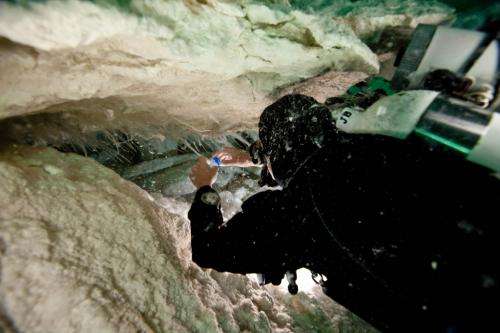Credit: Steve Trewavas
(Phys.org) —Deep in water-filled underground caves beneath Australia's Nullarbor Plain, cave divers have discovered unusual 'curtains' of biological material – known as Nullarbor cave slimes.
Researchers Sasha Tetu, Katy Breakwell, Liam Elbourne, Andrew Holmes, Michael Gillings and Ian Paulsen from Macquarie University, are exploring how this alien ecosystem works. They published their findings this week in the journal of the International Society for Microbial Ecology, showing that an unusual combination of microbes thrive in the Weebubbie caves.
"Earlier studies on the community suggested that there was an unusual chemistry going on in the caves, but we didn't know how the microbes were making a living in the cave environment," says the lead scientist Professor Ian Paulsen, Macquarie University.
In order to find this 'missing link', the team of researchers made use of a range of new technologies, such next-generation sequencing of environmental DNA and scanning electron microscopy to take an in-depth look at the composition of the Weebubbie cave slime community. This approach detected a dominant group of organisms in the cave slimes, known as the Thaumarchaeota. This community of microbes thrives in the total dark, independent of photosynthesis.
It is thought that the periodic inundations of the Nullarbor caves by the sea occurred a number of times in the geological past and so researchers suggest that the Weebubbie Thaumarchaeota may have a marine origin.
"We know that the Nullarbor Plain's karst system arose from the sea in the Middle Miocene period and so this may be a clue as to where the Weebubbie Thaumarchaeota came from," says Professor Paulsen
The research team says this analysis shows that the organisms make up the Weebubbie cave slime community make their living in a very unusual way – by oxidizing ammonia in the salty cave water – and are completely independent of sunlight and ecosystems on the surface.
"It just goes to show that life in the dark recesses of the planet comes in many strange forms, many of which are still unknown," says Professor Paulsen.
Provided by Macquarie University





















